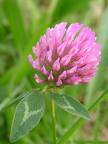Scientific Classification:
|
Other Common Names:
The other common names for the herb redclover are Trefoil, Purple Clover, Cow Clover, Meadow Clover, Purple Clover and Meadow Honeysuckle, Meadow Trefoil, Wild Clover, Cleaver Grass, Marl Grass and Cow Grass.History

Description


Range
Red Clover is a perennial herb, origin believed to be Britain where it is abundant, now a world wide escape; naturalized in nearly every country, even the Arctic Circle and high up into mountains. It is also distributed in some areas of northern Africa, as well as in some areas of central Asia. Nowadays, the red clover is also cultivated in the Americas and in Australia for pasturage and as a rotation crop.
Habitat
Redclover generally grows in fields, meadows and roadsides.
Cultivation
The red clover because of its nitrogen fixation ability is often used as a rotation crop and is also widely cultivated as animal feed in pastures. Red Clover is an easily grown plant, from seed or root cuttings, requires little attention. The long root is rhizome, and sends out runners, producing several stems 1 to 2 feet high, slightly hairy; leaves ternate, leaflets ovate, slightly toothed, ending in long point often lighter colored V shape in center, flowers red to purple, fragrant, in dense terminal ovoid or round heads. During summer, the floral heads of the red clover open out and the flower heads are collected for use in herbal preparations. Blooming from April thought out the summer months. Harvest flowers and dry for later herb use as it comes into bloom. Harvest edible leaves for salad before flowers fully bloom.
Flowering Season
The flowers of the redclover are generally in full bloom between the months of April to November.Pests and Diseases
A number of pests can attack clover plants, but routine control measures are not considered worthwhile. Red clover is even more susceptible to leatherjackets than grasses, although it will eventually recover after most attacks. Although a number of diseases can affect red clover, there are no routine recommendations for their control.
Parts Used
 |
The blossoms of the flowers are the most commonly used part for its medicinal and commercial applications. |
Medicinal Applications

- Redclover is said to have antispasmodic properties.
- It is also used in treating bronchitis, whooping-cough and asthma.
- Fomentations and poultices of the herb have been used as local applications to cancerous growths.
- Redclover speedens up the process of healing wounds and other external injuries.
- It is also used in the treatment of skin diseases such as psoriasis and other external conditions.
- It gives relief from menopausal symptoms.
- The expectorant action of the red clover is also made use of in many herbal preparations, especially in the treatment of spasmodic coughs which are persistent.
- Traditionally used as a as a blood purifier, expelling toxins from the bloodstream.
- Red Clover stimulates the production of digestive fluids and bile.
- It is also said to relieve constipation and help soothe inflammation of the bowel, stomach and intestines.
- Red Clover stimulates eostrogenic activity, thus possibly increasing fertility and reducing "hot flashes" experienced by women during menopause.
Commercial Applications
- Red Clover is edible and medicinal, the young leaves and new flowers are harvested, and are used in salads, soups, or as a pot herb.
- Red Clover is widely cultivated and used as a tonic and a salad herb, and it is used by honey makers to add a mild, sweet taste to their honey.
- Redclover serves as common fodder for domestic animals.
Symbolism
The three leaves were said to correspond to the triad goddesses of Mythology, and later to the Holy Trinity in Christianity. The flowering tops are used medicinally.
Folklore and Myths
Redclover is used to ward off witches and other evil forces, finding a four leaved clover has always been considered a lucky charm. Traditionally, a rare four leaf red clover specimen is believed to bring good luck and children in America love hunting through a patch of red clover for such rare four leaf specimens of the plant. Tradition holds that clover is the favorite plant of the fairies. Holding clover in your hand is thought to gain you "fairy sight"." To live in clover," from the insect's point of view at least, may well mean a life of luxury and affluence. Most peasants in Europe will tell you that a dream about the flower foretells not only a happy marriage, but long life and prosperity. For ages the clover has been counted a mystic plant, and all sorts of good and bad luck were said to attend the finding of variations of its leaves which had more than the common number of leaflets. At evening these leaflets fold downward, the side ones like two hands clasped in prayer, the end one bowed over them. In this fashion the leaves of the white and other clovers also go to sleep, to protect their sensitive surfaces from cold by radiation, it is thought. Add to the bath water to aid in financial dealings of all manners. Can be used in lust potions and sprinkle an infusion to remove negative spirits. In the middle ages the clover was considered a charm warn to ward off evil spirits and witches. The four leaf clover was said to have even more power against evil, a five leaf clover was said to be warn by witches to give them evil powers, and a two leaf clover would give a maiden the power to see her future lover.


